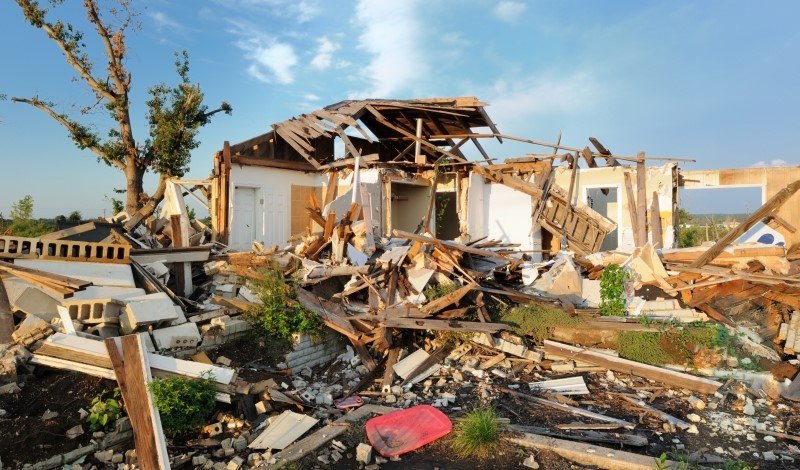
Scholars discuss reforming federal disaster preparedness, response, and recovery.
Last week, two major wildfires burned across more than 25,000 acres of New Mexico, destroying an estimated 1,400 structures and forcing the evacuation of around 8,000 residents. Despite wildland firefighters’ best efforts, the two fires are presently only about 70 percent contained. And although President Joseph R. Biden recently directed federal agencies to help in the response, these fires illustrate the difficulties policymakers face in responding to the worsening effects of climate change.
Over the past decade, the human and financial costs of climate disasters have grown substantially. Experts attribute this trend to three primary factors. First, increased development resulting from increased per capita wealth exposes more assets and individuals to the effects of disasters, particularly in high-risk areas such as coastlines. Second, the degradation of critical infrastructure exacerbates asset vulnerability when disasters occur and can hamper effective disaster response and recovery.
Finally, climate change increases the frequency and severity of natural disasters. Rising global temperatures lead to more droughts, more water in the atmosphere, and higher average wind speeds, making major natural disasters such as hurricanes, wildfires, and floods deadlier and more common.
Some scholars argue that the predominantly reactive U.S. approach to disaster response, recovery, and relief is insufficient to meet the new and complex problems posed by climate change. U.S. disaster policy is largely based on the Stafford Act, a federal law that authorizes federal assistance and financial support only once a disaster has been recognized by the President. But importantly, state, local, and tribal governments are primarily responsible for coordinating relief for disasters that occur within their jurisdictions. Because of the associated costs, officials from states or tribes affected by major disasters almost always request help from the Federal Emergency Management Agency (FEMA), which administers federal disaster relief funds.
Although Congress recently offered more funding for mitigation and resilience efforts, the pressure of worsening climate change places additional demands on disaster relief agencies and programs at a time when they are already facing substantial challenges. Over the last several years, federal disaster relief agencies have faced ongoing operational budget and staffing shortages, reducing their ability to respond to disasters and guide recovery efforts. In addition, the unpredictable nature of disasters makes additional funding essential to respond effectively when the largest disasters strike. For most of the last decade, however, Congress has acted slowly, often taking months to make needed recovery funding available following major natural disasters.
Proponents of increasing the federal government’s role in disaster relief suggest that FEMA and other federal agencies must shift from a reactive posture to a disaster and climate resilience paradigm. Similarly, some commentators propose that a more streamlined, less complex approach is necessary to ensure equity in federal disaster preparedness, response, and recovery.
In this week’s Saturday Seminar, scholars explain the limitations of the current regulatory framework for disaster preparedness, response, and recovery and discuss possible reforms.
- Congress and executive agencies should streamline fragmented federal natural disaster recovery efforts, the Government Accountability Office (GAO) writes in a recent report. More than 40 years of developing disaster response and recovery programs without centralized oversight or planning has resulted in more than 30 agencies administering federal disaster recovery programs, GAO explains. GAO argues that such a lack of centralized management or oversight makes it difficult for state officials, community leaders, and individuals to navigate federal recovery assistance programs after disasters strike and limits progress on climate resilience and equity goals. GAO urges the creation of an independent commission to recommend legislative and agency regulation reforms and coordinate federal disaster recovery efforts.
- Effective natural disaster response requires granting FEMA cabinet agency status and sole responsibility for major federal disaster relief programs, Carlos Martín, Carolyn Kousky, Manann Donoghoe, and Karina French argue in a recent article for The Brookings Institution. The Martín team explains that the patchwork nature of federal disaster management creates coordination and communication problems that limit federal disaster response effectiveness. Responding to the growing number of natural disasters requires a centralized authority to manage all major disaster relief programs and communicate with states and communities, Martín and his coauthors claim. They suggest that FEMA, the federal agency with the most relevant expertise and experience, is the best candidate for this role.
- Using private contractors to administer federal disaster recovery aid is more efficient than relying on states and federal agencies, writes Ike Brannon in an article for the CATO Institute. Brannon notes that FEMA and other agencies struggle to incorporate GAO recommendations to improve disaster recovery efforts. He argues that staffing shortages and other inefficiencies identified by GAO are exacerbated by restrictive regulations on federal agencies. Because they operate under fewer regulations, Brannon explains, contractors are able to respond to disasters more rapidly and efficiently. Brannon also claims that private contractors help states to administer federal disaster relief funding more efficiently, and can actually increase equity by helping make states with less bureaucratic capacity more competitive for grants and federal support.
- The national shift to a climate-resilience paradigm for disaster response and recovery is leaving rural communities behind, argue Kevin Manuele of Global Commercial Insights and Mark Haggerty in a recent article for The Center for American Progress. The authors explain that rural communities face high risk from natural disasters, but often lack the capacity to meet the complex, expensive application requirements of FEMA’s Building Resilient Infrastructure and Communities program, the largest source of climate resilience project funding. To help the program build rural climate resilience, Manuele and Haggerty propose changing award criteria to value appropriately projects scaled to smaller communities, as well as aligning application requirements with other federal resilience grants.
- Moving from a reactive to a proactive framework for dealing with climate-induced natural disasters requires a fundamental shift in disaster law, writes Mark Nevitt, a professor at Emory Law School in a forthcoming article for the Vanderbilt Law Review. U.S. disaster law, Nevitt notes, is fundamentally reactive, and largely provides for federal intervention only after disasters occur. Nevitt argues that this reactivity traps the federal government’s resources in a wasteful cycle of disaster, response, and recovery. Breaking free of this cycle is a prerequisite, Nevitt suggests, to managed climate adaptation. Limiting exposure to climate-induced disasters therefore requires reforming disaster law to include not only reactive response and relief, but also proactive strategies of mitigation, resilience, and retreat, Nevitt claims.
- In an article for the Lewis and Clark Law Review, Nancy J. Knauer, a professor at Temple Law School, writes that the United States’ decentralized disaster preparedness, response, and recovery model reflects federalist principles and recognizes that local actors are often best suited to understand their own needs. Knauer notes, however, that U.S. disaster policy also leads to fragmented authority and a lack of accountability. Knauer recommends Congress develop real-time disaster assistance monitoring and encourage whistleblowers to report fraud. Knauer also calls for the appointment of a federal disaster ombudsman to ensure equity and efficiency across federal disaster programs. These reforms, Knauer argues, would allow policy makers to address key weaknesses while maintaining flexibility and responsiveness to local needs.
The Saturday Seminar is a weekly feature that aims to put into written form the kind of content that would be conveyed in a live seminar involving regulatory experts. Each week, The Regulatory Review publishes a brief overview of a selected regulatory topic and then distills recent research and scholarly writing on that topic.



